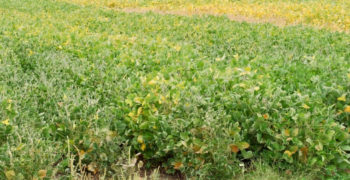Background:
Evaluating hail damage in the field and determining whether to replant can be difficult. There are many variables to consider as you are deciding whether to replant or continue with the existing crop. Determining how hail affects yield depends on the severity of the hail and when the damage occurs.
Soybeans are pretty resilient to hail damage throughout development, besides newly emerging plants who are extremely sensitive to hail damage. The reason why emerging plants are the most sensitive to hail damage is because the hypocotyl tissue is the first part of the plant that is exposed. This portion of the stem below the cotyledons is at the most risk. Any damage to the hypocotyl tissue will cause the plant to die.
Soybean plants with majority amounts of green tissue and at least one cotyledon attached are likely to survive early season hail damage. This is possible by the axillary buds which will promote new growth. The yield potential of hail damaged soybeans largely depends on the remaining population, growth stage of the plant when damaged, and the severity of the damage. Soybeans have an amazing capability of rebounding from leaf loss. Plants with remaining green tissue will develop new leaves. Soybeans can be completely defoliated at V6-R1 stages and still produce 80-90% of their yield.
Management:
If you choose to keep the existing crop, take care to ensure this field produces as much as possible. The crop has already experienced tremendous stress, reducing futures stresses is beneficial to a high yield. One of the most important and difficult challenges with hail damaged crops is weed control. An open crop canopy can be challenging to maintain adequate weed control.



